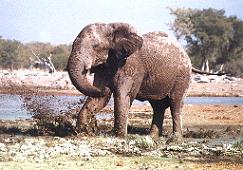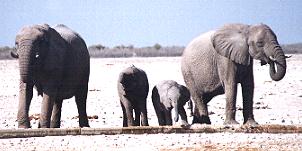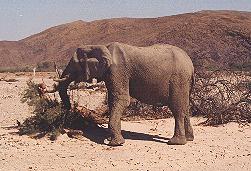African elephants
Information about African elephants on
example of Etosha's elephants
The number of
elephants in
Etosha National Park
is around 2000. The most usual appearance is small family units and bull herds. A large
herds are made up of small units, each unit consisting of a matriarch, several adult cows
and offspring of different ages. Grown up young bulls are forced out of these units at the
age of about 12-15 years and later they join bull herds. The tasks of elephants in Etosha
which are actually two upper front teeth do not attain significant lengths mostly
attributable to mineral deficiency. Another reason is that elephants use the tasks for
digging up a roots and breaking the tips of tasks in process.
The Etosha elephants are regarded as tallest in Africa. To
regulate the body temperature they often use stomach water spraying it over the body or
using large ears as radiators continually flopping them. Elephants have only four molars
in use at a time. As these are worn down they get replaced by new ones. Elephants can be
destructive around waterholes and the surrounding areas can be severely damaged and
deforested.
Etosha's elephant in a playful mood
The diet of elephants consists of
grass, bark of tree branches, leaves, roots and fruits.
 The
average elephant eats approximately 230 kilograms of fodder per day and drinks up to 180
litres of water. One (very seldom two) calve is born after a 22-month gestation
period. Elephant can weight up to 6000 kilograms and has a shoulder height up to 3 meters.
There are approximately 10 000 elephants in Namibia although they became almost extinct at
the end of last century due to hunting and poaching. Most of the population of elephants
occurs in the north-eastern parts of the country.
The
average elephant eats approximately 230 kilograms of fodder per day and drinks up to 180
litres of water. One (very seldom two) calve is born after a 22-month gestation
period. Elephant can weight up to 6000 kilograms and has a shoulder height up to 3 meters.
There are approximately 10 000 elephants in Namibia although they became almost extinct at
the end of last century due to hunting and poaching. Most of the population of elephants
occurs in the north-eastern parts of the country.
At the conference of CITES (Convention on International Trade in Endangered Species) that
has been held in Kenya recently the decision to delay ivory sales for the period of
two years has been taken.
Desert elephants
Desert-dwelling elephants in the
north-western part of Namibia are special for several reasons. They are one
group of only two known populations of desert-dwelling elephants in the world.
The other group is in Mali. They are uniquely adopted to extremely dry and sandy
conditions - they have a smaller bodies and larger feet than other elephants. By
the 1980's most of 3000 elephants that lived in Namibia's Kunene Region were
killed by hunters and poachers. Because of measures that were taken to protect
desert elephants their population is approximately 600 at the moment.
Their diet is varied and changes from wet to dry seasons. Most popular species
include Commiphora, Mopane tree, Ana tree.
All potential visitors to areas where desert elephants can be found have to
remember that these animals have poor eyesight but good hearing and smell.
Elephants can also move very fast. The visitors must stay quiet in their
vehicles, never chase elephants when they move away, view elephants from
downwind side and allow a distance of 100 metres between them, never drive in
the night, leave the area if animal appears to be nervous.
Image: desert elephant
in Hoarusib riverbed near Purros, Kaokoland
@
Desert-dwelling elephants of the North-west
Accommodation as a base to see
desert elephants:
Brandberg Rest Camp
Brandberg
White Lady Lodge
Damaraland Camp
Doro
!Nawas Camp
Huab Lodge
Khorixas Rest Camp
Twyfelfontein Lodge
Ozohere Camp
Contact &
information:
E-mail:
info@namibweb.com



Page created and serviced by

www.namibweb.com
Copyright © 1998-2025
namibweb.com - The online guide
to Namibia
All rights reserved |
JOIN
|
VIDEO PORTFOLIO
|
VIDEO/PHOTO COLLECTION
Telegram
| YouTube |
Blog
Page is sponsored by ETS &
Exploring Namibia TV
Disclaimer: no matter how often this page is updated and its accuracy is checked,
www.namibweb.com and ETS
will not be held
responsible for any change in opinion, information, facilities, services,
conditions, etc. offered by
establishment/operator/service/information provider or any third party
